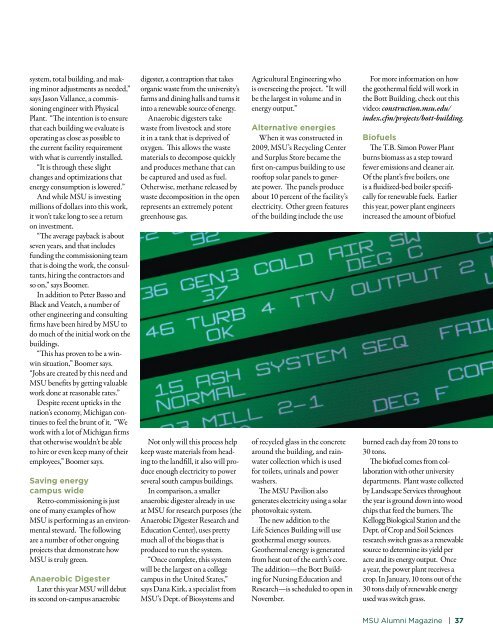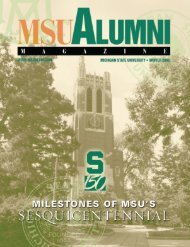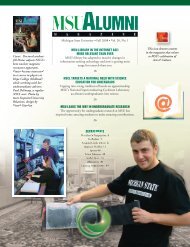Raving fans wear Spartan jewelry - MSU Alumni Association ...
Raving fans wear Spartan jewelry - MSU Alumni Association ...
Raving fans wear Spartan jewelry - MSU Alumni Association ...
You also want an ePaper? Increase the reach of your titles
YUMPU automatically turns print PDFs into web optimized ePapers that Google loves.
system, total building, and making<br />
minor adjustments as needed,”<br />
says Jason Vallance, a commissioning<br />
engineer with Physical<br />
Plant. “The intention is to ensure<br />
that each building we evaluate is<br />
operating as close as possible to<br />
the current facility requirement<br />
with what is currently installed.<br />
“It is through these slight<br />
changes and optimizations that<br />
energy consumption is lowered.”<br />
And while <strong>MSU</strong> is investing<br />
millions of dollars into this work,<br />
it won’t take long to see a return<br />
on investment.<br />
“The average payback is about<br />
seven years, and that includes<br />
funding the commissioning team<br />
that is doing the work, the consultants,<br />
hiring the contractors and<br />
so on,” says Boomer.<br />
In addition to Peter Basso and<br />
Black and Veatch, a number of<br />
other engineering and consulting<br />
firms have been hired by <strong>MSU</strong> to<br />
do much of the initial work on the<br />
buildings.<br />
“This has proven to be a winwin<br />
situation,” Boomer says.<br />
“Jobs are created by this need and<br />
<strong>MSU</strong> benefits by getting valuable<br />
work done at reasonable rates.”<br />
Despite recent upticks in the<br />
nation’s economy, Michigan continues<br />
to feel the brunt of it. “We<br />
work with a lot of Michigan firms<br />
that otherwise wouldn’t be able<br />
to hire or even keep many of their<br />
employees,” Boomer says.<br />
Saving energy<br />
campus wide<br />
Retro-commissioning is just<br />
one of many examples of how<br />
<strong>MSU</strong> is performing as an environmental<br />
steward. The following<br />
are a number of other ongoing<br />
projects that demonstrate how<br />
<strong>MSU</strong> is truly green.<br />
Anaerobic Digester<br />
Later this year <strong>MSU</strong> will debut<br />
its second on-campus anaerobic<br />
digester, a contraption that takes<br />
organic waste from the university’s<br />
farms and dining halls and turns it<br />
into a renewable source of energy.<br />
Anaerobic digesters take<br />
waste from livestock and store<br />
it in a tank that is deprived of<br />
oxygen. This allows the waste<br />
materials to decompose quickly<br />
and produces methane that can<br />
be captured and used as fuel.<br />
Otherwise, methane released by<br />
waste decomposition in the open<br />
represents an extremely potent<br />
greenhouse gas.<br />
Not only will this process help<br />
keep waste materials from heading<br />
to the landfill, it also will produce<br />
enough electricity to power<br />
several south campus buildings.<br />
In comparison, a smaller<br />
anaerobic digester already in use<br />
at <strong>MSU</strong> for research purposes (the<br />
Anaerobic Digester Research and<br />
Education Center), uses pretty<br />
much all of the biogas that is<br />
produced to run the system.<br />
“Once complete, this system<br />
will be the largest on a college<br />
campus in the United States,”<br />
says Dana Kirk, a specialist from<br />
<strong>MSU</strong>’s Dept. of Biosystems and<br />
Agricultural Engineering who<br />
is overseeing the project. “It will<br />
be the largest in volume and in<br />
energy output.”<br />
Alternative energies<br />
When it was constructed in<br />
2009, <strong>MSU</strong>’s Recycling Center<br />
and Surplus Store became the<br />
first on-campus building to use<br />
rooftop solar panels to generate<br />
power. The panels produce<br />
about 10 percent of the facility’s<br />
electricity. Other green features<br />
of the building include the use<br />
of recycled glass in the concrete<br />
around the building, and rainwater<br />
collection which is used<br />
for toilets, urinals and power<br />
washers.<br />
The <strong>MSU</strong> Pavilion also<br />
generates electricity using a solar<br />
photovoltaic system.<br />
The new addition to the<br />
Life Sciences Building will use<br />
geothermal energy sources.<br />
Geothermal energy is generated<br />
from heat out of the earth’s core.<br />
The addition—the Bott Building<br />
for Nursing Education and<br />
Research—is scheduled to open in<br />
November.<br />
For more information on how<br />
the geothermal field will work in<br />
the Bott Building, check out this<br />
video: construction.msu.edu/<br />
index.cfm/projects/bott-building.<br />
Biofuels<br />
The T.B. Simon Power Plant<br />
burns biomass as a step toward<br />
fewer emissions and cleaner air.<br />
Of the plant’s five boilers, one<br />
is a fluidized-bed boiler specifically<br />
for renewable fuels. Earlier<br />
this year, power plant engineers<br />
increased the amount of biofuel<br />
burned each day from 20 tons to<br />
30 tons.<br />
The biofuel comes from collaboration<br />
with other university<br />
departments. Plant waste collected<br />
by Landscape Services throughout<br />
the year is ground down into wood<br />
chips that feed the burners. The<br />
Kellogg Biological Station and the<br />
Dept. of Crop and Soil Sciences<br />
research switch grass as a renewable<br />
source to determine its yield per<br />
acre and its energy output. Once<br />
a year, the power plant receives a<br />
crop. In January, 10 tons out of the<br />
30 tons daily of renewable energy<br />
used was switch grass.<br />
<strong>MSU</strong> <strong>Alumni</strong> Magazine | 37
















